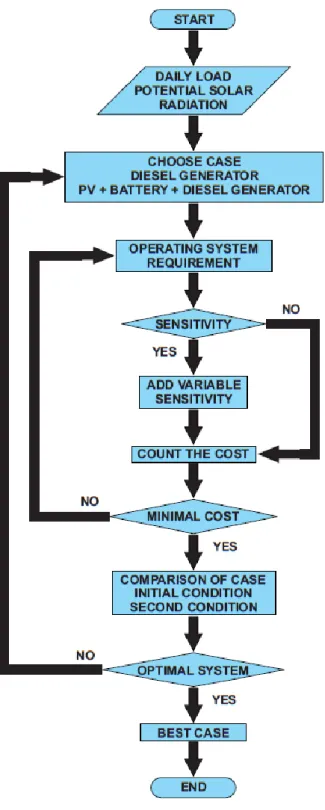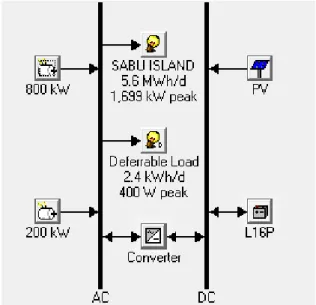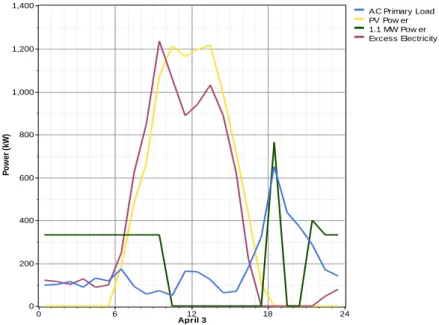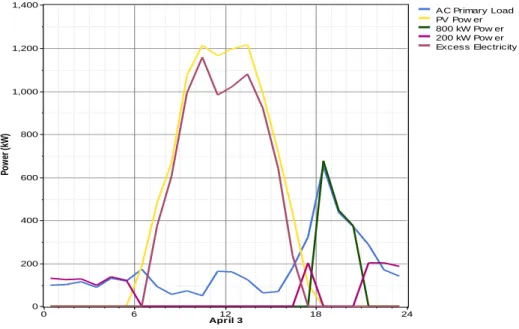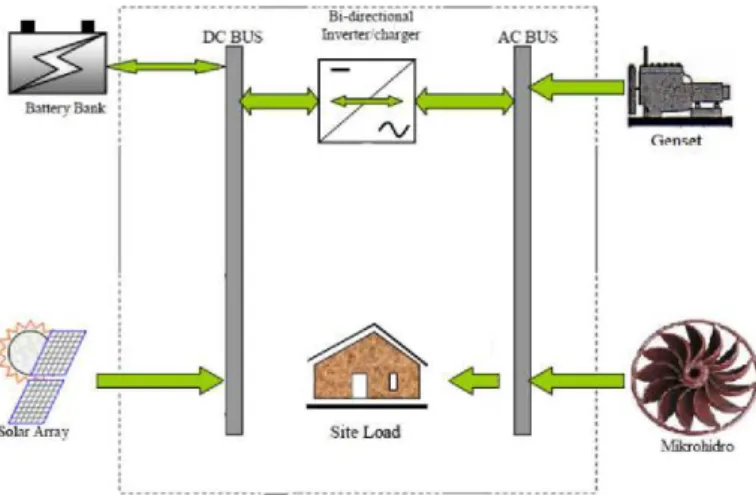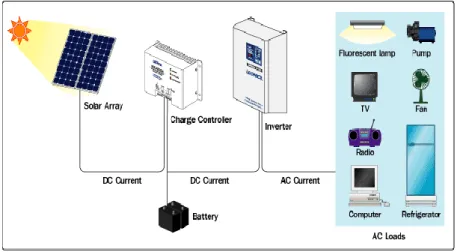As a result, 88.9% of households on Sabu Island still use wells as a source of clean water [7]. Cann,tot is the annual cost of the total system ($ / year) Cketel is margin boiler cost ($ / kWh).
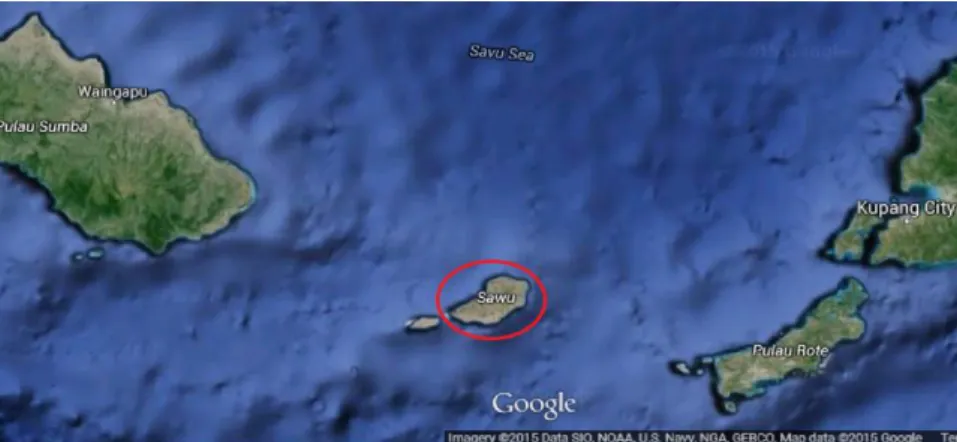
Implementation Study Hybrid Power Plant in Sabu Island
- Simulation and Optimization Methods
- Power Hybrid Models in Sabu Island
- Sizing Each Components of Hybrid System .1 Photovoltaics
- Hybrid Power Plant Components
- Solar Modules
- Diesel Generator
- Inverter
- Battery
- Variable Sensitivity
- Operating Limits Power Hybrid
Ppeak = maximum power of the photovoltaic field under STC [kWp] Eel = real electrical output energy of the system [kWh / a]. When looking at inverter specifications, pay attention to the inverter's part-load efficiency.
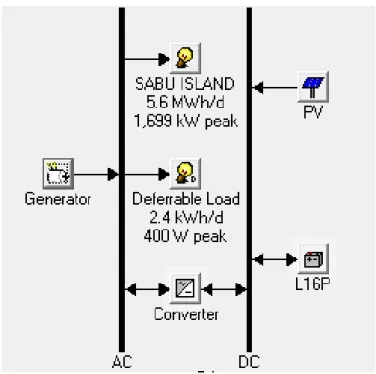
Summary
For design optimization, Hybrid Power Plant system is made of two conditions by following the daily load curve, i.e. And the operating limits are the operating system used is a parallel system of Hybrid Power Plant, constraints economics are used for all calculations when the hybrid system is simulated a real annual interest rate of 8%, 25 years project period, the dispatch strategy used is a charge cycle with the set point state of charge of 80%, maximum annual capacity shortfall 0%, for generator control system allowed to operate with some generators and systems also allowed to operate the generator during peak load.
Simulation Results
Initial Condition
- Peak Power of Photovoltaic
- Battery Capacity
This system with initial conditions consists of 1,100 kW diesel generator, 1,500 kW PV, 6,643 pieces of battery and 1,500 kW inverter with simulation results as follows in Table 4.1 below.
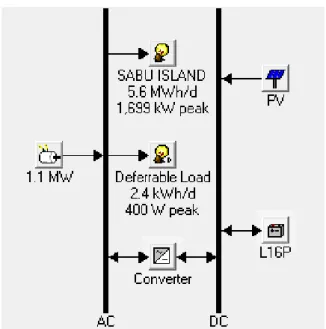
Second condition
This state system consists of two diesel generators with capacity of 800 kW and 200 kW, 1,500 kW PV, 6,643 pieces of battery and 1,500 kW inverter with the simulation results as follows in Table 4.2 above. The second state simulation is run by changing the value of the capacity and number of each solar and diesel generator according to the lowest NPC value.
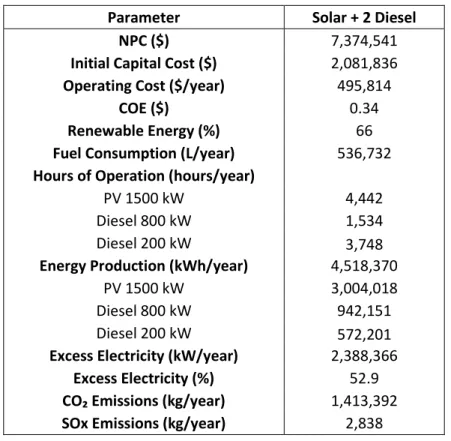
Comparison of Results All Conditions
Analysis of Simulation Results
Initial Condition
- Electricity Production
- Fuel Consumption
- Excess Unused Power
- Costs
- Environmental Impact (Emission)
This happens because the excess electricity from the Diesel Generator cannot be utilized because there are no batteries to store electrical energy in this system. Excess electricity is the difference between the total production of electrical energy in a year generated by the Diesel Generator and the total load supplied.
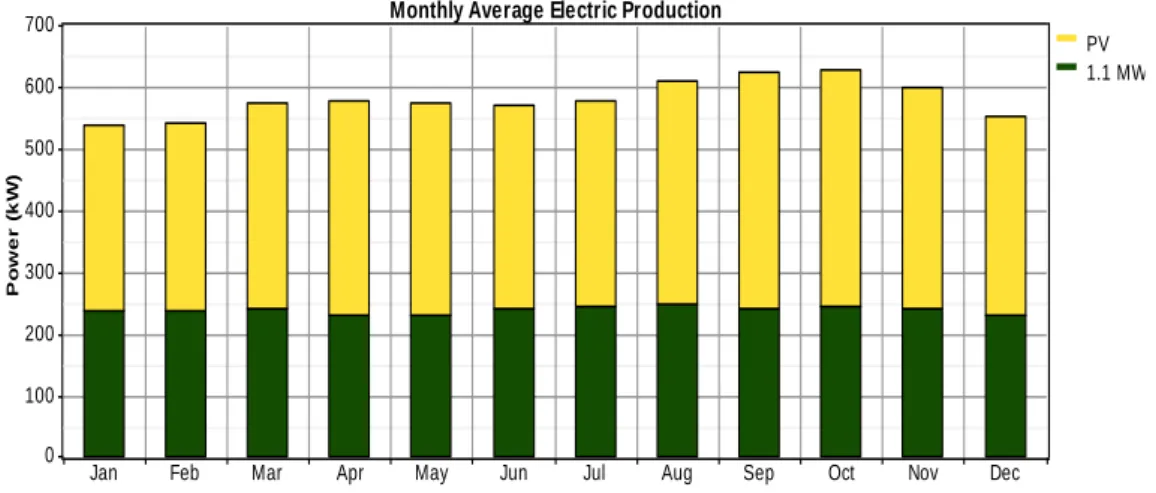
Second condition
- Electricity Production
- Fuel Consumption
- Excess Unused Power
- Costs
- Environmental Impact (Emission)
In Figure 4.5, the fuel consumption on the system configuration of Hybrid Power Station consisting of Solar Power Plant - Diesel Generator amounted to 590,684 liters per year. With a fixed daily load, excess unused power has a value that fluctuates with the total production of electricity in Hybrid Power Station.
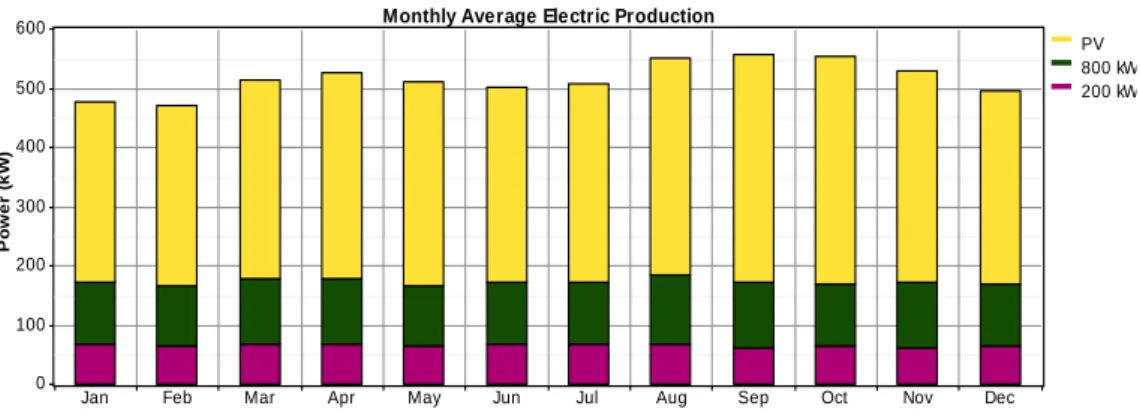
Summary
In the diagram of CO₂ emissions, the highest value occurs when the contribution of ET 0% with the total value CO₂ is 1,856,939 kg per year. Under these conditions, simulations were performed with the original condition compared to the second condition.
CONCLUSIONS
With the case study of solar power plant optimization on Sabu Island, Nusa Tenggara Province, integrated with Diesel Generator. Aided simulation and optimization results HOMER software shows that the overall optimal system to be implemented in the above study area is the integration between solar power plant and diesel generator.

INTRODUCTION
Photovoltaic System by Homer Energy
Objective and Purpose of the Study
Scope of Limitation
Benefits of Project
BASIC THEORY
Basic Principles
A PV array is a combination of several solar panels arranged in series and parallel to produce a certain value of voltage with a desired power. A diesel generator required as a combination of power to be able to supply the load, especially during peak load or when battery stored energy conditions are at a lower level. The Battery Bank or battery circuit is part of a hybrid power plant whose function is to store energy obtained from solar panels.
Bi-Directional inverter, is a two-way converter that changes the DC voltage from the battery to AC voltage or vice versa from AC to DC to charge the energy system to a battery.
Solar Power Plant
- Main Components of Solar Power Plants .1 Solar Modules
- Regulating Device
- Battery / Accu
- Working Principle of Solar Power Plants
- Calculation Determination of Total Solar Module
- Determining the Amount Relations Series of Solar Module
- Determining the Amount Relations Parallel Solar Module
- Working Principle and Components of Diesel
- Advantages and Disadvantages of Diesel
- Advantages when using diesel
- Disadvantages when using diesel
Electricity generated by the module can be supplied directly to the load or stored in batteries before being used for charging. At night, when the solar modules are not generating electricity, the load is fully supplied by the battery. Likewise, if the day is cloudy, in which the solar modules generate electricity, is lower than when the sun is clear.
Electricity generated by the module can be delivered directly to the load or stored in batteries before use to load: light, radio, etc. Similarly, if the day is cloudy, where the solar modules generate electricity is lower than when the bright sun. Centralization (solar power plants located in an area and the electricity produced is channeled through the distribution network to places that need it) and decentralized (solar power plant installed in each home, thus no distribution network needed) can be used.
Modular; The obtained electrical power can be adjusted to the needs by assembling the modules in series and in parallel. When the resulting fractions are rounded up, we can later calculate the nominal current of the photovoltaic generator ( ) using the following formula.
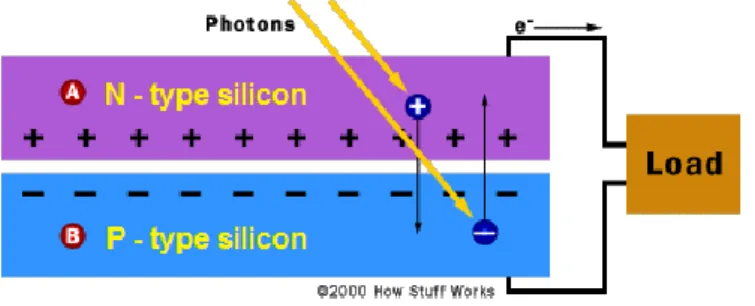
Hybrid Power Plant
- Working Principle of Hybrid Power Plant
- Operating System of Hybrid Power Plant
- Serial System of Hybrid Power Plant .1 Working Principle of Serial System
- Switched System of Hybrid Power Plant .1 Working Principle of Switched System
- Parallel Systems of Hybrid Power Plant .1 Working Principle of Parallel Systems
The Solar Power Plant system as a whole is a multi-variable system that used the help of the software, in this case HOMER version 2.68. Based on the map of solar energy in Indonesia, every Indonesian has a good potential for developing a solar energy plant. Generally, generation systems are widely used for hybrid power plants are a diesel generator, solar power plant, micro-hydro, wind power plants.
The contribution of solar power plants is not fixed at any time, as solar power plants are highly dependent on natural conditions. However, in line with the purpose of diesel power plant operation, which saves fuel and reduces CO₂ emissions, diesel operation is the last variable that follows the change in power supply of solar power plants, so its contribution depended on about the power supply of the solar power plants. Due to the integrated operation of the solar power stations on hybrid power stations, fuel consumption and CO₂ emissions can be reduced.
Solar Power Plant is a power generation technology that converts photons from solar energy into electrical energy. Solar power plants use sunlight to generate direct current (direct current) electricity, which can be converted to alternating current (alternating current) when needed. This device also has several indicators that will provide convenience to solar power plant users by providing information about the battery condition so that the user can control the solar power according to the availability of electrical energy consumption in the batteries.
Source: http://solarsuryaindonesia.com/info/solar-home-system 2.2.3 Advantages and disadvantages of solar power plants.
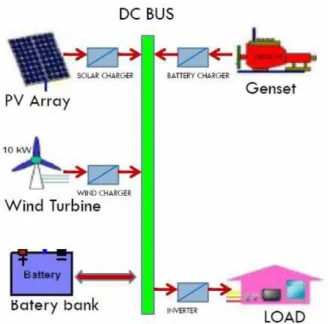
Geography and Administrative Conditions
Compared to other small islands in East Nusa Tenggara Province, Sabu Island is quite remote and has the longest distance to the islands around it, such as to Sumba, Rote and Flores Islands. This condition makes sea freight transportation modes to be the most important role for Sabu Raijua community in relation to other islands in East Nusa Tenggara province. This topography increases physical isolation, economic isolation and social isolation, especially due to the lack of supporting infrastructure such as roads and bridges in various sub-districts.
While transportation on some islands is often quite expensive due to the low frequency of means of transport on some islands, which certainly affects the prices of goods and services in the district.
Meteorological Conditions and Electricity
- Potential Solar Radiation
- Electrical Conditions
- Daily Load
Electricity demand on Sabu Island is assumed to be supplied only by Diesel Generator throughout the day with a peak load of 1 MW. If there is a maintenance and repair on one of the machines will be replaced by an available machine. Sabu Island including remote island, had to use ferry boats to reach, this led to the supply of fuels including diesel fuel being scarce, so the price becomes very expensive.
Sabu Island Hybris Power Plant models will be simulated with daily load curves and deferred loads. It is believed that the main load data in the form of daily load data is located in Sabu Island and obtained under PT's Electricity Supply Business Plan. While the deferred load data is the pump load that is assumed to be added to the hybrid power plant system.
PLN (State Electricity Company) is the assumed daily load data for a full day, the image below is a predicted daily load curve according to the population needs in Sabu Island. This load is in the form of a water pump with a maximum load of 400 watts running for 6 hours a day.
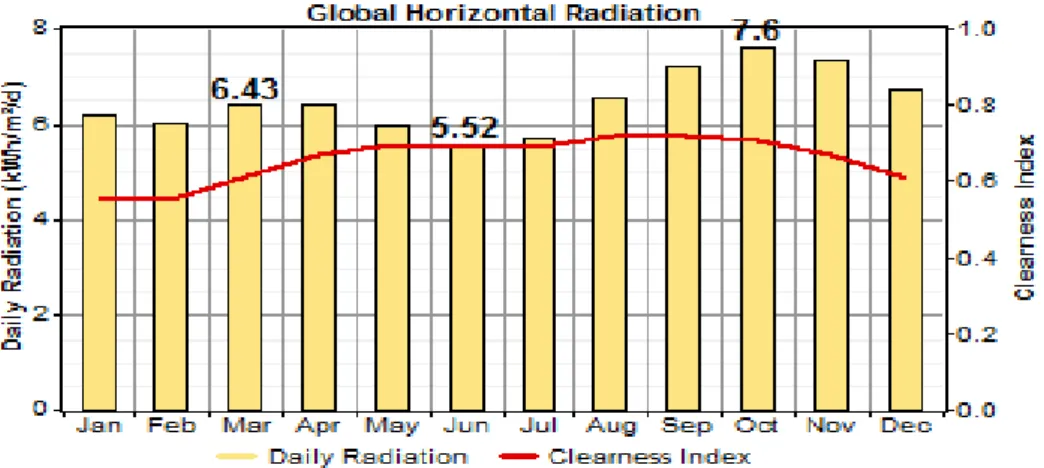
HOMER Software
- Simulation
- Optimization
- Sensitivity Analysis
- Calculation of Data
- Levelized Cost of Energy
- Calculation of Emissions
Pb is the energy of the battery in the time interval Pbh is the total energy generated by the PV array. Total net present cost (NPC) is the most important economic output for the value of a hybrid power plant system, HOMER will sort the data output of the simulation and optimization based on the lowest value of NPC. While the closure of the capital factor can be obtained using the following formula.
The first condition simulation is run to determine the initial conditions of the load supply system in Sabu Island using the minimum value of each component. The second state simulation is run by changing the value of the capacity and number of each solar and diesel generator according to the lowest NPC value and less emissions. The value of PV power rounded to 1,500 kWp and the battery capacity divided by the nominal capacity of the battery of 2.16 kWh, so we get the amount of battery capacity of 6,643 pieces.
Excess electricity is unused in this system is 2,388,366 kWh per year or 52.9 %, this happens due to the electricity that is exceeded by the Solar Power Plant for one year than the existing load. In the initial state, the value of PV power is rounded up to 1,500 kWp and the battery power capacity is divided by the nominal capacity of the battery at 2.16 kWh so that we get the amount of battery capacity of 6,643 pieces. The first condition simulation is performed to determine the initial conditions of the load supply system in Sabu Island using the minimum value of each component.
In the second condition, the simulation is performed by changing the value of the capacity and number of each solar and diesel generator in accordance with the NPC Lowest value and less emissions.
